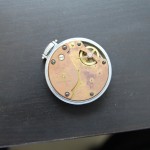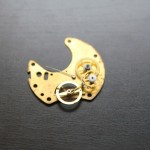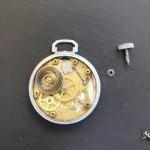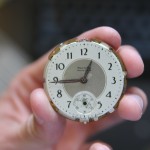Quick Background
This is different than things I usually post about. There have been some exciting developments on my other projects and I hope to post on those soon.
While cleaning out some old family items, I recently came across a few pocket watches. I was immediately drawn in by this piece: a Westclox Pocket Ben watch. I was intrigued in no small part because it is a dollar watch; a category of watch targeted the average person. A slight personal fascination with mechanical watches helped too.
Mechanical Era
We often talk about the democratizing potential of new technologies. I don’t have much personal context on this beyond the information age of smartphones and the Internet. However, were I a betting man I’d wager this effort to democratize technological advances is far from new. I think mechanical watches are both a historical example of this and the pinnacle of their era.
Tear Down
The watch was not working when I received it, the second hand broken off and it seems it had not worked for some time. It’s not a particularly valuable watch in any condition. I timeboxed several hours yesterday to attempt to take it apart and understand how it works. Here’s what I learned:
- This watch was stamped “38” on the movement, signifying it was made in 1938.
- There is no magic. The internals of the watch expose its secrets, gears and springs mostly.
- Watches are assembled by hand, therefore they can be understood with eyes and manipulated with hands.
- Be discerning: trust your hands, don’t be forceful but the pieces sometimes need caressing.
- Westclox took a number of shortcuts to save money, particularly leaving the spring exposed, and sometimes replacing gears with pins that are distributed to fake acting as gears.
- Despite being relatively low cost and a few shortcuts, the work is honest, glue was avoided oil minimal and tolerances respected.
- The balancer is attached to the back of movement, which means the watch basically has to be assembled from the back forward. It would have been nice to learn this one earlier than being one step away from back together.
Community
There is a small online community interested in watches like these (surprise, online community). One particularly helpful source was two videos showing a very honest dissection and assembly of these watches, the videos highlight the creators thoughts and frustrations. He clearly has much more experience than I with watches and tools that are better equipped.
The disassembly video: https://www.youtube.com/watch?v=xAMU64fzuKU
The reassembly video: https://www.youtube.com/watch?v=fKnS61s1diE
I would be curious to know more about these watches from a historical perspective. I think it would also be particularly interesting to do an interview with people who worked on devices like this. Semi-specialized hand labor was a trademark of 20th century industry and is quickly fading. I imagine the story of watches like this will fade unless recorded soon.
References
I liked this page showing some the various Westclox Pocket Ben watches. The watch I have pretty clearly is closest to the advertised 1933 watch, which matches the printed 1938 date.
Next up
I unfortunately didn’t finish reassembling the watch. I was one step away from having it back together when I realized that the balancer must be integrated much sooner. This resulted in me assembling in the opposite direction and unable to finish in the time I had allotted. I hope to someday have a chance to revisit this.











